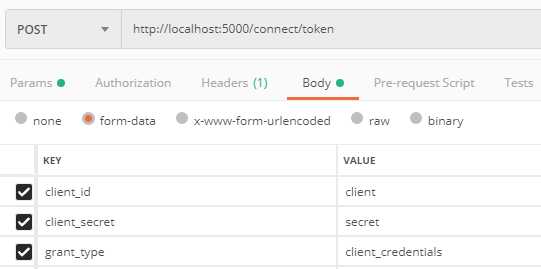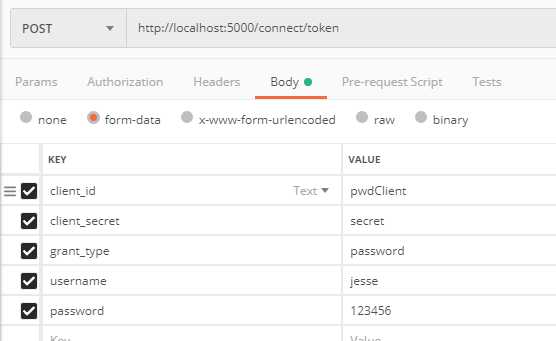标签:依赖 计算 substring session new t 有用 Nid login task
Session认证和JWT(Json Web Token)
Token认证就是基于JWT
1.Session认证
1. 用户输入其登录信息
2. 服务器验证信息是否正确,并创建一个session,然后将其存储在数据库中
3. 服务器为用户生成一个sessionId,将具有sesssionId的Cookie将放置在用户浏览器中
4. 在后续请求中,会根据数据库验证sessionID,如果有效,则接受请求
5. 一旦用户注销应用程序,会话将在客户端和服务器端都被销毁
2.JWT认证
1. 用户输入其登录信息
2. 服务器验证信息是否正确,并返回已签名的token
3. token储在客户端,例如存在local storage或cookie中
4. 之后的HTTP请求都将token添加到请求头里
5. 服务器解码JWT,并且如果令牌有效,则接受请求
6. 一旦用户注销,令牌将在客户端被销毁,不需要与服务器进行交互一个关键是,令牌是无状态的。后端服务器不需要保存令牌或当前session的记录。
JWT里面只存放了一些不敏感的信息 比如一些重要的信息是用户发起请求 验证身份成功 再去 ProfileService 中把敏感信息放到HttpContext中 比如租户ID 等
服务器不保存生成Token Token由三部分组成 根据客户端请求的Token 根据Token的前部和中部和密钥计算出来跟尾部相同 就验证通过 节约了服务器内存
http://www.ruanyifeng.com/blog/2014/05/oauth_2_0.html
用VS 直接运行就报错 但是用VS Core打开 用dotnet run命令运行就没有报这个错误
IdentityServer4配置成功后 配置页面 localhost:xxxx/.well-known/openid-configuration

身份验证服务器需要添加IdentityServer4 包
客户端只需要添加IdentityServer4.AccessTokenValidation 包
进销存用的是密码模式
相当于经销存和protal protal是身份验证服务器
经销存只是一个客户端 只需要添加IdentityServer4.AccessTokenValidation

1.用户在第三方客户端上操作的时候 想要访问接口地址 先去授权服务器认证
2.授权服务器通过验证后 会通过ProfileService 把用户信息包装成一个Claim 放返回
3.请求会加上返回的Claim 里面有用户信息 资料 token
注:如果是通过Postman测试 下面这样传参没问题 如果是通过前端来获取token 会报错400 Bad Request
都是post接口 通过抓包软件分析 传递的参数是

在前端需要对参数进行格式化 转成字符串 然后把Content-type改成application/x-www-form-urlencoded
var param = ‘‘;
let data = {
client_id:‘Consoleclient‘,
client_secret:‘511536EF-F270-4058-80CA-1C89C192F69A‘,
grant_type:‘client_credentials‘
};
for (let property in data) {
param += `&${property}=${data[property]}`
}
param = param.substring(1, param.length)
this.apiService.identityLoginAPI(param).then(res => {
Claim是用户身份 一个用户可以有多个身份
Scope是API资源的权限
1.客户端模式
进销存前端需要调用后端API 需要先到protal 的IdentityServer服务器 经过授权 拿到token 才能访问到后端API
获取token 传参方式

2.密码模式
需要输入真实账户和密码 这种模式body 可以设置为form-data 也可以设置为x-www-form-urlencoded

3.授权码模式
做一个统一的登陆界面 比如Pc端在Web上进行QQ登陆 然后比如登陆斗鱼的时候 可以用QQ账号密码登陆 也会跳转到QQ登陆的统一界面
搭建身份验证服务器
.Net Core的项目模版生成出来后 默认是https访问 在properties中的launchSettings.json中把sslport改为0
"iisExpress": {
"applicationUrl": "http://localhost:5000",
"sslPort": 0
}
1.新建一个空web Api项目
添加IdentityServer4包 这里用的版本都是2.1
添加Config.cs配置类信息
这是客户端模式配置
public class Config
{
/// <summary>
/// 配置资源服务器
/// </summary>
/// <returns></returns>
public static IEnumerable<ApiResource> GetResource()
{
return new List<ApiResource>
{
new ApiResource("api","My Api")
};
}
/// <summary>
/// 配置客户端
/// </summary>
/// <returns></returns>
public static IEnumerable<Client> GetClients()
{
return new List<Client>
{
new Client()
{
ClientId = "client",
AllowedGrantTypes = GrantTypes.ClientCredentials,
ClientSecrets ={
new Secret("secret".Sha256())
},
AllowedScopes = { "api"}
}
};
}
}
2.把IdentityServer添加到依赖注入配置项
public void ConfigureServices(IServiceCollection services)
{
services.AddIdentityServer()
//添加开发证书
.AddDeveloperSigningCredential()
//添加资源Api
.AddInMemoryApiResources(Config.GetResource())
//添加客户端
.AddInMemoryClients(Config.GetClients());
services.AddMvc().SetCompatibilityVersion(CompatibilityVersion.Version_2_2);
}
3.在管道中添加身份验证服务器中间件
app.UseIdentityServer();
4.启动的时候可能会报错 第一次配报错 第二次配没有报错 如果报错用Vs Code 打开 用dotnet run 命令运行
进入http://localhost:5000/.well-known/openid-configuration查看配置
"token_endpoint":"http://localhost:5000/connect/token", 这个地址就是获取token的地址

到这里 身份验证服务器搭建完毕 后面开始搭建客户端服务器 也就是接口服务器
1.新建一个Web Mvc空项目
添加IdentityServer4.AccessTokenValidation包
注入是身份验证服务器 这里的地址就是上面配的验证服务器地址
services.AddAuthentication("Bearer")
.AddIdentityServerAuthentication(Options =>
{
Options.Authority = "http://localhost:5000";
Options.RequireHttpsMetadata = false;
Options.ApiName = "api";
});
2.在管道中开启授权验证中间件
app.UseAuthentication();
3.在需要保护的接口上添加[Authorize]特性
4.直接访问现在的接口 就会报错401 没有授权
先通过http://localhost:5000/connect/token 身份验证服务器拿到token 再去访问api接口
第二种 帐号密码模式
修改验证服务器的Config.cs
public class Config
{
public static IEnumerable<ApiResource> GetResource()
{
return new List<ApiResource>
{
new ApiResource("api","My Api")
};
}
public static IEnumerable<Client> GetClients()
{
return new List<Client>
{
//客户端模式
new Client()
{
ClientId = "client",
AllowedGrantTypes = GrantTypes.ClientCredentials,
ClientSecrets ={
new Secret("secret".Sha256())
},
AllowedScopes = { "api"}
},
//账号密码模式
new Client()
{
ClientId = "pwdClient",
AllowedGrantTypes = GrantTypes.ResourceOwnerPassword,
ClientSecrets ={
new Secret("secret".Sha256())
},
AllowedScopes = { "api"}
}
};
}
/// <summary>
/// 添加一个模拟的帐号密码
/// </summary>
/// <returns></returns>
public static List<TestUser> GetTestUsers()
{
return new List<TestUser>{
new TestUser{
SubjectId = "1",
Username="jcb",
Password = "123456"
}
};
}
}
2.把账号密码模式也进行注入 修改Startup.cs
services.AddIdentityServer()
.AddDeveloperSigningCredential()
.AddInMemoryApiResources(Config.GetResource())
.AddInMemoryClients(Config.GetClients())
.AddTestUsers(Config.GetTestUsers());
这样就完成了帐号密码模式的配置
把账号密码模式改为动态的 通过数据库进行匹配
1.新增登录验证器类LoginValidator 继承IResourceOwnerPasswordValidator 接口有一个验证方法ValidateAsync
public class LoginValidator : IResourceOwnerPasswordValidator
{
public async Task ValidateAsync(ResourceOwnerPasswordValidationContext context)
{
Customers customers = new Customers() { Name = context.UserName };
var res = await Login(customers);
if (res != null)
{
//GrantValidationResult实例根据构造函数传参不同来进行判断是否成功
context.Result = new GrantValidationResult(res.Id.ToString(), "password", (IEnumerable<Claim>)null, "local", (Dictionary<string, object>)null);
}
else
{
}
}
//登录验证可以写这里
public async Task<Customers> Login(Customers customer)
{
using (MyDbContext db = new MyDbContext())
{
var res = db.customers.FirstOrDefault(t=>t.Name == customer.Name);
if (res != null)
{
return res;
}
return null;
}
}
}
2.在注册身份验证服务器的时候 把这个登录验证添加进来
.AddResourceOwnerValidator<LoginValidator>();
3.这样子执行的时候 默认会使用自带的DefaultProfileService 执行到内部IsActiveAsync()方法会报错 这个类在C:\Users\jiangchengbiao\.nuget\packages\identityserver4\2.1.0\lib\netstandard2.0\IdentityServer4.dll
解决方式:需要新建一个类 继承IProfileService 重写里面的IsActiveAsync() 然后再把这个注册到身份验证服务器上
public class ProfileService : IProfileService
{
public async Task GetProfileDataAsync(ProfileDataRequestContext context)
{
//通过第一次验证输出的账号密码 查询到租户ID等其他信息 添加到身份信息中
List<Claim> claims = Enumerable.ToList<Claim>(context.Subject.Claims);
claims.Add(new Claim("http://schemas.xmlsoap.org/ws/2005/05/identity/claims/nameidentifier", "蒋承标"));
claims.Add(new Claim("http://schemas.xmlsoap.org/ws/2005/05/identity/claims/name", "浙江工贸"));
claims.Add(new Claim("http://jcb.org/identity/claims/tenantId", "租户ID"));
context.IssuedClaims = claims;
}
public async Task IsActiveAsync(IsActiveContext context)
{
context.IsActive = true;
int num = await(Task<int>) Task.FromResult<int>(0);
}
}
4.把重写的ProfileService 注册到身份验证服务器上
public void ConfigureServices(IServiceCollection services)
{
services.AddIdentityServer()
.AddDeveloperSigningCredential()
.AddInMemoryApiResources(Config.GetResource())
.AddInMemoryClients(Config.GetClients())
.AddTestUsers(Config.GetTestUsers())
.AddProfileService<ProfileService>()
.AddResourceOwnerValidator<LoginValidator>();
services.AddMvc().SetCompatibilityVersion(CompatibilityVersion.Version_2_1);
}
到这里就完成了 可以根据输入的帐号密码到数据库进行比对
然后在客户端(也就是经销商系统)启动JWT中间件 参数一定要是这个 还没具体去看
app.UseJwtTokenMiddleware("IdentityBearer");
ctx.AuthenticateAsync会去身份验证服务器中把 各种身份信息查询出来 这里面有租户ID 用户姓名等 放到HttpContext中
public static class JwtTokenMiddleware
{
public static IApplicationBuilder UseJwtTokenMiddleware(this IApplicationBuilder app, string schema = JwtBearerDefaults.AuthenticationScheme)
{
return app.Use(async (ctx, next) =>
{
if (ctx.User.Identity?.IsAuthenticated != true)
{
var result = await ctx.AuthenticateAsync(schema);
if (result.Succeeded && result.Principal != null)
{
ctx.User = result.Principal;
}
}
await next();
});
}
}
1.客户端安装Nuget包
IdentityServer4.AccessTokenValidation
Microsoft.AspNetCore.Authentication.Abstractions
Microsoft.AspNetCore.Authentication.Cookies
Microsoft.AspNetCore.Authentication.OpenIdConnect
客户端代码
public void ConfigureServices(IServiceCollection services)
{
services.AddDbContext<SchoolDbContext>(d=>d.UseSqlServer(Configuration.GetConnectionString("Default")));
JwtSecurityTokenHandler.DefaultInboundClaimTypeMap.Clear();
services.AddAuthentication(options =>
{
options.DefaultScheme = "Cookies";
options.DefaultChallengeScheme = "oidc";
})
.AddCookie("Cookies")
.AddOpenIdConnect("oidc", options =>
{
options.Authority = "http://localhost:5000";
options.RequireHttpsMetadata = false;
options.ClientId = "mvc";
options.SaveTokens = true;
});
services.AddMvc();
}
标签:依赖 计算 substring session new t 有用 Nid login task
原文地址:https://www.cnblogs.com/yanglang/p/12236156.html